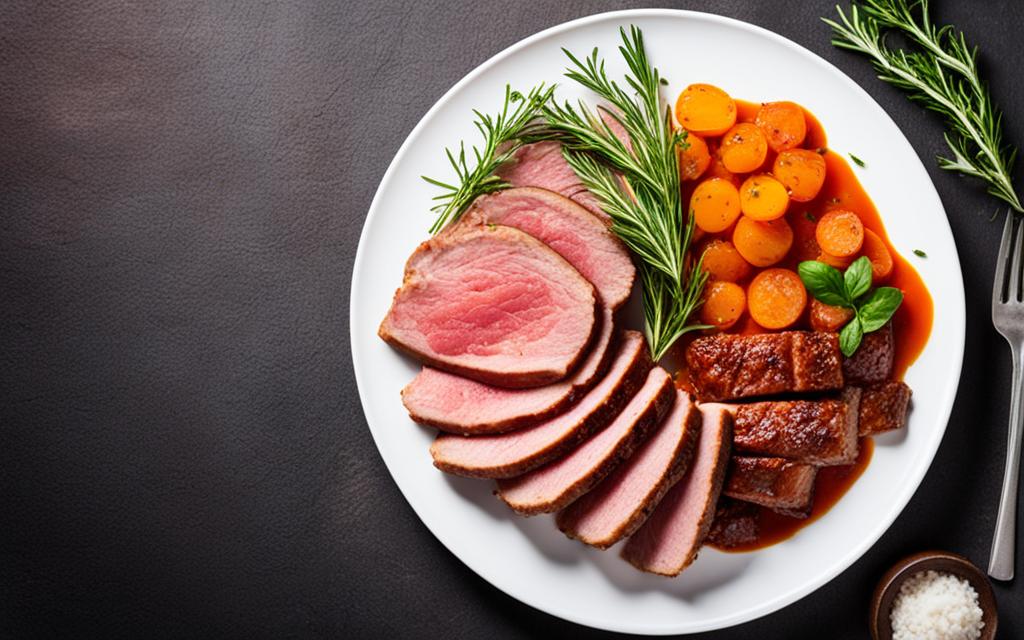When it comes to the world of meat, the flavor and texture of lean cuts can be quite distinct from their fattier counterparts. As a health-conscious consumer, you may be wondering, “What does lean meat taste like?” This article will provide an in-depth look at the unique characteristics of lean meat, including its flavor profile, mouthfeel, and the best ways to prepare it. Whether you’re a fan of lean cuts or looking to incorporate more into your diet, this guide will give you valuable insights into the nuances of lean meat.
Lean meat is a versatile and nutritious ingredient that can be a delicious addition to your meals. By understanding the characteristics of lean meat and the cooking tips for lean meat, you can unlock its full potential and enjoy the flavor and texture that it has to offer. So, let’s dive in and explore the world of lean meat together.
What is Lean Meat?
Lean meat is a type of meat that is low in fat and high in protein. It is defined as meat that contains less than 10 grams of fat per 100 grams of product. Lean meats are considered a healthier option as they are lower in saturated fat and calories, while still providing a good source of essential nutrients like protein, iron, and B vitamins. Some examples of lean meats include chicken breast, turkey breast, pork tenderloin, and certain cuts of beef and lamb.
The nutritional benefits of lean meat make it an excellent choice for those looking to maintain a balanced and healthy diet. Lean meat is a rich source of high-quality protein, which is essential for building and repairing muscle tissue, as well as supporting overall bodily functions. Additionally, the reduced fat content of lean meat means you can enjoy the satisfaction of a protein-packed meal without the added calories and saturated fat found in fattier cuts.
| Nutrient | Lean Meat | Fatty Meat |
|---|---|---|
| Protein | High | High |
| Fat | Low | High |
| Saturated Fat | Low | High |
| Calories | Low | High |
By incorporating lean meats into your diet, you can enjoy the savory flavors and satisfying textures of meat while also benefiting from its excellent nutritional profile. Whether you choose chicken, turkey, pork, or select cuts of beef, lean meat provides a versatile and healthy protein source to support your overall well-being.
Flavor Profile of Lean Meat
The flavor profile of lean meat is often described as mild, delicate, and slightly sweet. The lack of fat in lean cuts means there is less flavor-carrying lipids, resulting in a cleaner, more subtle taste. Lean meats also tend to have a slightly firmer texture and less juiciness compared to fattier cuts. However, this can be mitigated through proper cooking techniques to retain moisture and enhance the natural flavors.
The flavor profile of lean meat is often praised for its versatility, allowing it to pair well with a variety of seasonings and cooking methods. Whether you’re grilling, searing, or roasting lean cuts, the goal is to bring out the inherent sweetness and subtle nuances of the meat without overwhelming it. With the right preparation, lean meat can be just as satisfying and flavorful as its fattier counterparts.
Understanding the flavor profile of lean meat is crucial for making the most of this nutritious protein source. By appreciating the unique characteristics of lean cuts, you can unlock a world of delicious and healthy meal possibilities. From lean chicken breasts to pork tenderloin, exploring the flavor profile of lean meat can open up new culinary horizons and help you incorporate more of these versatile proteins into your diet.
Texture and Mouthfeel of Lean Meat
One of the defining characteristics of lean meat is its distinct texture and mouthfeel. Due to the lower fat content, lean meats generally have a firmer, denser texture compared to fattier cuts. This can make them feel slightly chewy or dry in the mouth if not cooked properly. However, lean meats can also be quite tender when prepared correctly, as the lack of fat allows the muscle fibers to remain intact. The mouthfeel of lean meat is often described as clean, lean, and satisfying, without the heavy or greasy sensation that can come from higher-fat meats.
The texture and mouthfeel of lean meat can be greatly impacted by the cooking method used. Overcooking can lead to a dry, tough texture, while proper cooking techniques can enhance the natural tenderness and juiciness of lean cuts. Understanding the unique texture and mouthfeel characteristics of lean meat is crucial for achieving the best possible eating experience.
Cooking Lean Meat Perfectly
Properly cooking lean meat is crucial to bringing out its best flavor and texture. Because lean cuts have less fat, they can easily become dry and tough if overcooked. Some tips for cooking lean meat include:
- Use a meat thermometer to ensure you don’t overcook the meat. The internal temperature of lean meat should reach 145°F for medium-rare or 160°F for medium doneness.
- Marinate the lean meat in a flavorful liquid, such as broth, wine, or a combination of herbs and spices, to help keep it moist and tender during cooking.
- Sear the lean meat over high heat to create a nice crust, then finish cooking at a lower temperature to prevent dryness.
- Baste the lean meat regularly with its own juices or a flavored basting liquid to keep it moist.
- Let the lean meat rest for 5-10 minutes before slicing to allow the juices to redistribute, ensuring a juicy and flavorful result.
By following these cooking tips for lean meat, you can enjoy the delicious taste and tender texture of this healthy protein source. Remember, the key is to cook lean meat with care and attention to prevent it from becoming dry or tough.
Conclusion
In conclusion, lean meat offers a unique flavor and texture profile that is distinct from fattier cuts of meat. While lean meat is often described as mild and delicate in flavor, it can be very satisfying when prepared properly. By understanding the characteristics of lean meat and following best practices for cooking, you can enjoy the health benefits and delicious taste of these leaner protein sources.
Whether you’re looking to incorporate more lean meat into your diet or simply want to learn more about this versatile ingredient, this guide has provided valuable insights into what lean meat tastes like and how to make the most of it in your cooking. By mastering the art of cooking lean meat perfectly, you can unlock a world of flavor and texture that will leave you feeling satisfied and nourished.
So, the next time you reach for a lean cut of meat, remember the insights you’ve gained from this article. Embrace the unique flavor profile and texture of lean meat, and use the right cooking techniques to bring out the best in this healthful and delicious protein source. With a little knowledge and care, you can elevate your meals and enjoy the many benefits of incorporating more lean meat into your diet.










